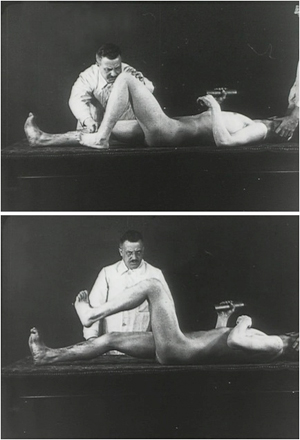By Bernd Holdorff

Bernd Holdorff
Tonic neck reflexes in animals and men were described by Magnus and de Kleyn in 1912.
It became his most important publication and remained unsurpassed for the next years. A film from the years 1916-1919, with Arthur Simons as examiner, shows these nearly forgotten phenomena. (See Figure 1.) He already emphasized their everyday significance in 1920, long before the rules of antispastic positions were defined by Bobath.
After several clinical activities, mostly in unpaid positions, and subsequently as the leading assistant in the outpatient service (Poliklinik) of Hermann Oppenheim in the years before WWI, Simons (1877-1942) had to do military service as a physician from 1914 to 1918. He succeeded in assembling neurological case reports and publications to fulfill the academic requirements for the “Privatdozent” or “Habilitation Act” in 1921 and for a professorship (a.o.= extraordinary professor) in 1923.
After Oppenheim’s death in 1919, he worked in an outpatient practice and as consultant neurologist in Berlin hospitals until 1933, where he was continuously deprived by the Nazi regime, because of his Jewish origin. Requests for immigration to England failed and meanwhile his private practice lost more and more patients. In 1938, he lost his medical license and had to accept the profession of “Krankenbehandler.” Alimony for his divorced wife forced him to sell more and more of his art collections as well as his household. In September 1942, he did not return from a citation to the Gestapo, and after intermediate detention in October 1942, he was taken to Reval (the present Tallinn, Estonia) where he was murdered.

Figure 1. Still with Arthur Simons as examiner. Upper part: left hemiplegia after brainshot wound, metal rod loosely in the right hand, paretic leg slightly bent and passively held by Simons Lower part: head rotated to right, hemiplegic associated reactions (Mitbewegungen) on the left side elicited by voluntarily right forced grasp: abduction of upper arm, elbow flexion, elevation of the left hand and fist clench, flexion of hip and knee, adduction of the thigh, dorsiflexion of the foot and the toes as well as inversion. (Not shown here: head rotation to the left in combination with voluntarily forced grasp of the right hand resulting in slight extension, adduction and pronation of the forearm, hand extension and clench of the fingers, as well as left leg in strong extension, inward rotation, foot flexion and toe extension.)
In 1912, Magnus and de Kleyn, in the Netherlands, studied in detail the labyrinthine and the postural reflexes in animals as well as humans. Following Rudolf Magnus, tonic neck reflexes are the consequence of a change of the position of the head in relation to the trunk, which causes an increase or decrease of tonus of ipsilateral muscles (asymmetrical tonic neck reflexes), while dorsi- and retro-flexion of the head results in bilateral change of tonus (symmetrical tonic neck reflexes).
As a result of Magnus’ animal experiments, the anatomical basis of tonic neck reflexes could be located in the upper cervical spine. They are decreased after extirpation of the first cervical root and completely disappear after cutting of the second cervical root. Tonic neck reflexes are elicited in the newborn during the first weeks and reappear only in cerebral disease.
After the coincidental observation in his first patient at the military hospital, Simons wrote: “In the autumn 1916, I examined a hemiplegic patient in the field two months after an injury by gunshot in the head”1. Simons undertook a thorough series of investigations, and at the end of the war, he had observed 31 hemiplegics. By 1919, he had seen 248 cases, of which 25 percent presented tonic neck reflexes with hemiplegic “Mitbewegungen” (synkinesias). He produced a film (Filmarchiv, Bundesarchiv, Berlin) that shows 11 cases from the years 1916-1919, mostly with war brain injuries.
The asymmetric neck reflexes with flexion or extension on the hemiplegic side, called “Mitbewegungen” (synkinesias), identical to Francis Walshe’s “associated reactions” (1923)2, are induced (increased or varied) by neck rotation with simultaneous co-contraction of the non-affected extremities, e.g. by closure of the fist. They are restricted to the paralyzed side. The stills shown in Figure 1 are taken from the film.
Investigations by Simons and Walshe were done exclusively in the adult and awake hemiplegic, show that tonic neck reflexes are bound to a lesion of the pyramidal tract and should be understood as a form of decerebrate rigidity. They belong to Magnus’ postural reflexes, or “Stellreflexe,” the English term of which is “position” or “righting reflexes” and are situated in the brain stem.
Walshe was fair enough to acknowledge Simons’ milestone discovery in his final addendum. In 1925, the Hamburg neurologist Heinrich Pette stated in his own investigation on tonic neck reflexes that “up to now, they remain unique in this manner of large scale work.” The reproduction of Simons’ film stills by Magnus in his 1924 Körperstellung3, by Rademaker in his 1931 Das Stehen, as well as by Stenvers in his chapter in Bumke’s & Foerster’s Handbook of Neurology (Vol. 5, 1936) bestowed them a historical value.
After that period, the couple Berta and Karl Bobath, in their English exile, used the neck reflexes in physiotherapy and position of hemiplegics in order to decrease their spastic tonus, unfortunately relying only on Walshe’s work and not on Simons’ efforts.
References
1. Simons A (1923) Kopfhaltung and Muskeltonus. Ges.Z. Neurol.Psychiatr. 80: 499-549.
2. Walshe FMR (1923) On certain or postural reflexes in hemiplegia, with special reference to the so-called “associated movements.” Brain 46: 1-37.
3. Holdorff B (2012): Arthur Simons (1877-1942) über tonische Halsreflexe beim Hemiplegiker aus den Jahren 1916-1919. Nervenarxt 83: 514-520.
